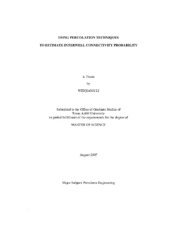| dc.description.abstract | Reservoir connectivity is often an important consideration for reservoir management. For example, connectivity is an important control on waterflood sweep efficiency and requires evaluation to optimize injection well rates. The uncertainty of sandbody distributions, however, can make interwell connectivity prediction extremely difficult. Percolation models are a useful tool to simulate sandbody connectivity behavior and can be used to estimate interwell connectivity. This study discusses the universal characteristics of different sandbody percolation models and develops an efficient percolation method to estimate interwell connectivity. Using King and others results for fluid travel time between locations in a percolation model, we developed a method to estimate interwell connectivity. Three parameters are needed to use this approach: the sandbody occupied probabilitysandp, the dimensionless reservoir length, and the well spacing. To evaluate this new percolation method, the procedure was coded using Visual Basic and Mathematica and the results compared to those from two other methods, a simple geometrical model and Monte Carlo simulation. All these methods were applied to estimate interwell connectivity for the D1, D2, and D3 intervals in the Monument Butte field. The results suggest that the new percolation method can give reasonable effective-square sandbody dimensions and can estimate the interwell connectivity accurately for thin intervals with sandp in the 60% to 80% range. The proposed method requires that the reservoir interval for evaluation be sufficiently thin so that 2D percolation results can be applied. To extend the method to 3D cases, we propose an approach that can be used to estimate interwell connectivity for reservoirs having multiple, noncommunicating layers, and that considers the weight of each interval for multilayer estimation. This approach is applied to the three-layer case of Monument Butte field and the estimates showed the method gives useful results for well pattern design. For example, water saturation and interval thickness affect the weight of each interval to be included in the multilayer estimation. For thick intervals or heterogeneous sandbody distributions, the percolation method developed here is not suitable because it assumes thin layers. Future percolation research will be needed to adapt this new percolation method. | en |


